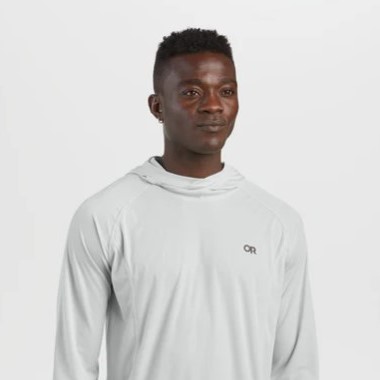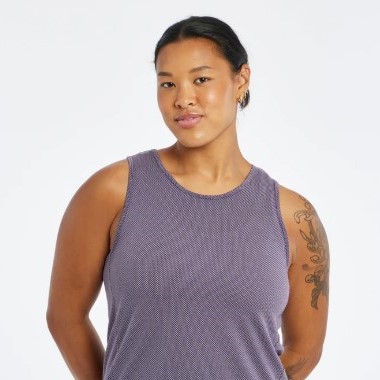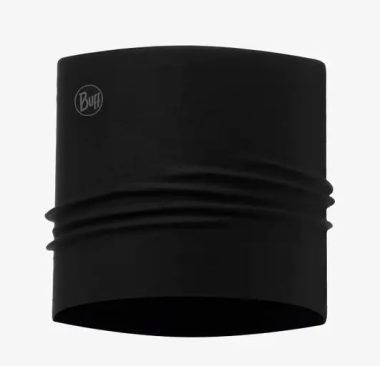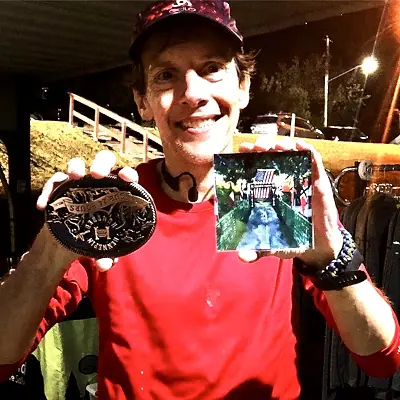
The best running gear for hot weather can make a significant difference. Photo: iRunFar/Eszter Horanyi
The best running gear for hot weather can make a significant difference in the summer — the season for long runs and goal races, sweltering temperatures, high humidity, and dangerous ultraviolet light levels. For many, after a winter of battling the cold, spring and summer bring glory days of running, and having the right gear ensures you can make the most of the long days.
Regardless of where you train, the best hot-weather running gear can help keep you safe, comfortable, and at your best when temperatures rise. While getting out for a run before sunrise or after things have cooled down for the day is always a good choice, if you need to run in the heat, it’s important to prepare for it. That’s why we’ve compiled this guide to the best running clothes for hot weather.
After thorough testing, we compiled our favorite products that will keep you cool, protect you from the sun, prevent chafing, and help you stay safe in sweltering temperatures — so you can run confidently throughout the hot summer months.
Our team continues to turn to the Patagonia Men’s Strider Pro Shorts – 5″ and the rabbit EZ Tee Perf SS for our basic clothing needs, and we accessorize with the Drymax Extra Protection Hot Weather ¼ Crew Socks and Smith Motive Sunglasses.
You can also skip down to read our recommendations on how to choose the best clothes for running in hot weather, our answers to your frequently asked questions about hot-weather running gear, and how we put this guide together.
Best Running Gear for Hot Weather
- Best Shorts: Patagonia Men’s Strider Pro Shorts – 5″ and Patagonia Women’s Strider Pro Shorts – 3½“
- Best Men’s Shorts — Runner-Up: Tracksmith Session Shorts
- Best Women’s Shorts — Runner-Up: Oiselle Roga Shorts
- Best Men’s Shirt: Montane Men’s Dart Nano T-Shirt
- Best Women’s Shirt: rabbit EZ Tee Perf SS
- Best Sun Shirt: Outdoor Research Echo Hoodie
- Best Tank Top: Oiselle Flyout Trail Tank
- Best Hat: Patagonia Duckbill Trucker Hat
- Best Neck Gaiter: Buff CoolNet UV Half Neckwear
- Best Socks: Drymax Extra Protection Hot Weather ¼ Crew Socks
- Best Sports Bra: Oiselle Hi Twenty Bra
- Best Hydration Pack: Salomon Adv Skin 12
- Best Sunscreen: Zealios Sun Barrier SPF 45 Sunscreen
- Best Sunglasses: Smith Motive Sunglasses
- Best Electrolyte Powder: Skratch Labs Hydration Sport Drink Mix

Lightweight shirts, hats, and sunglasses are all good options for running in hot weather. Photo: iRunFar/Eszter Horanyi
Best Shorts: Patagonia Men’s Strider Pro Shorts – 5″ ($85) and Patagonia Women’s Strider Pro Shorts – 3½” ($79)
 If there’s one thing that nearly all of our testers agreed on, it was that the Patagonia Men’s Strider Pro Shorts – 5″ and Patagonia Women’s Strider Pro Shorts – 3½“ were the best shorts for running in hot weather. When the temperatures soar, you don’t want your shorts to weigh you down. These shorts are featherweight at 3.7 ounces and made of 100% recycled polyester stretch ripstop fabric with a durable water-repellent (DWR) coating.
If there’s one thing that nearly all of our testers agreed on, it was that the Patagonia Men’s Strider Pro Shorts – 5″ and Patagonia Women’s Strider Pro Shorts – 3½“ were the best shorts for running in hot weather. When the temperatures soar, you don’t want your shorts to weigh you down. These shorts are featherweight at 3.7 ounces and made of 100% recycled polyester stretch ripstop fabric with a durable water-repellent (DWR) coating.
An external drawstring dials in the fit and five pockets, including one zippered for secure storage, make it easy to carry gels, a phone, and other necessities. The liner is made of 100% polyester to minimize odor, wick effectively, dry efficiently, and reduce chafing. The women’s version of the shorts has similar features for comfort and convenience and weighs only 2.8 ounces.
These shorts have been in our testing team’s rotation for a long time, and we reach for them repeatedly, whether heading out for a long mission in the mountains or a neighborhood jog. The men’s version of these shorts also comes in a 7-inch version if you want more coverage. One important thing to note in this Patagonia line is that the Strider Pros have pockets while the regular Striders do not.
Because of their quality, we’ve also named the men’s version of these shorts our favorite overall in our best running shorts for men guide.
Shop the Men's Patagonia Strider Pro Running Shorts 5-InchShop the Women's Patagonia Strider Pro Running Shorts 3-Inch
Best Men’s Shorts — Runner-Up: Tracksmith Session Shorts ($75)
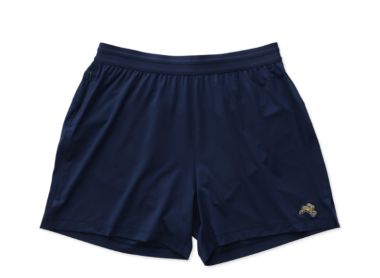 For a refreshingly basic, supremely comfortable pair of shorts that will serve you well in hot weather, look no further than the Tracksmith Session Shorts. What these shorts lack in storage and additional features, they make up for in comfort, softness, and simplicity.
For a refreshingly basic, supremely comfortable pair of shorts that will serve you well in hot weather, look no further than the Tracksmith Session Shorts. What these shorts lack in storage and additional features, they make up for in comfort, softness, and simplicity.
Since it began, Tracksmith has sought to combine the comfort of early cotton running apparel with modern features, and these shorts are its crown jewel in that regard. With a body made from 92% polyester and 8% spandex and a smooth new liner, the Session Shorts mimic the eternal comfort of cotton without compromising moisture management or odor control. These shorts will wick moisture well in hot weather and provide UV protection.
These shorts are among the most basic we tested, with only one external zip pocket and three internal pockets for gels or other small items, but they’ll offer a smooth, cool ride in hot weather.
For these reasons, we named these shorts the most comfortable in our best running shorts for men guide.
Shop the Men's Tracksmith Session ShortsBest Women’s Shorts — Runner-Up: Oiselle Roga Shorts ($58)
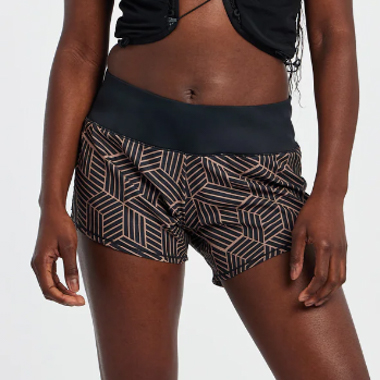 The Oiselle Roga Shorts are the type of everyday shorts that every runner needs in their repertoire, particularly if running in hot weather. Made with a fabric that is 86% polyester and 14% spandex, these shorts are light, flexible, and reliable — all hallmarks of a classic pair of shorts that have been around since Oiselle started.
The Oiselle Roga Shorts are the type of everyday shorts that every runner needs in their repertoire, particularly if running in hot weather. Made with a fabric that is 86% polyester and 14% spandex, these shorts are light, flexible, and reliable — all hallmarks of a classic pair of shorts that have been around since Oiselle started.
The defining features of these shorts are their flat waistband, large back zip pocket, and fabric that provides a four-way stretch for fluid movement without riding up. They’re relatively low-waisted, sitting below the belly button, with an internal drawcord to make adjustments to the fit and a built-in technical liner. And we haven’t even mentioned the prints! In addition to black, these shorts are often available in several fun colorways. For a stylish, reliable pair of shorts that will serve you well when the temperatures soar, the Roga shorts are hard to beat.
There are many reasons we named them our top shorts in our best running shorts for women guide, and you can read more about them in our in-depth Oiselle apparel review.
Shop the Women's Oiselle Roga ShortsBest Men’s Shirt: Montane Men’s Dart Nano T-Shirt ($65)
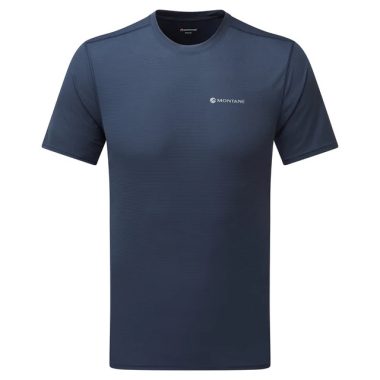 Weighing a mere 2.8 ounces, the Montane Men’s Dart Nano T-Shirt is a lightweight tee tailor-made for running in hot weather. Made with the company’s Apex Lite 100% recycled polyester material, this shirt is exceptionally comfortable and efficient at keeping moisture away from your body.
Weighing a mere 2.8 ounces, the Montane Men’s Dart Nano T-Shirt is a lightweight tee tailor-made for running in hot weather. Made with the company’s Apex Lite 100% recycled polyester material, this shirt is exceptionally comfortable and efficient at keeping moisture away from your body.
Sweating is inevitable, though, and this shirt has a Bluesign-approved Polygiene permanent odor control to help it feel — and smell — fresh for the long haul. Though we prefer merino wool for odor control, the Polygiene works well.
Our testers loved this shirt for the hot summer months and ran in it constantly. Though it’s relatively pricey and not necessarily a shirt you’d wear after the run like some other more fashionable options, its performance features make it a standout choice for running in the heat.
This shirt’s ability to perform in hot temperatures is one of the many reasons we’ve included it in our best running shirts for men guide.
Shop the Men's Montane Dart Nano T-ShirtBest Women’s Shirt: rabbit EZ Tee Perf SS ($48)
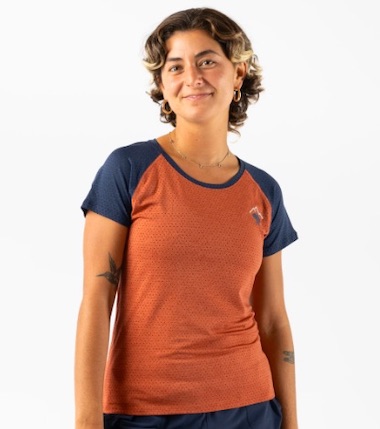 The rabbit EZ Tee Perf SS performs exceptionally well during hot runs, mainly due to its singular soft, perforated mesh, which makes it impossibly light and airy. The perforated fabric’s lightness, breathability, and flexibility set it apart from other shirts, and we felt it kept us cool and protected from the sun. The shirt, made of 94% polyester and 6% spandex, feels soft against the skin even when sweating during a tough workout.
The rabbit EZ Tee Perf SS performs exceptionally well during hot runs, mainly due to its singular soft, perforated mesh, which makes it impossibly light and airy. The perforated fabric’s lightness, breathability, and flexibility set it apart from other shirts, and we felt it kept us cool and protected from the sun. The shirt, made of 94% polyester and 6% spandex, feels soft against the skin even when sweating during a tough workout.
One of our testers wore this shirt for 30-plus miles on the Loowit Trail in Washington and loved it so much that she wore it for the rest of an epic series of summer adventures, from the 35-mile Ruby Crest Trail in Nevada to Oregon’s 40-mile Timberline Trail. After dunking it in streams to cool off from the summer heat, she found that the shirt did not weigh her down and dried quickly.
Some of our testers said the sizes run small, so you may want to consider ordering a size up for a more comfortable fit. The biggest problem you may find with this shirt is wanting to wear it all the time, not just during your runs.
We loved this shirt so much that we included it in our best running shirts for women guide. You can also find it in our rabbit warm-weather women’s apparel review.
Shop the rabbit EZ Tee Perf SS - Women's
When you wear the right gear, running in the heat is much more comfortable — and enjoyable. Photo: iRunFar/Eszter Horanyi
Best Sun Shirt: Outdoor Research Echo Hoodie ($75)
For extra protection from the sun, many runners turn to sun shirts — which come with long sleeves and a hood to cover more skin — and our favorite for running in hot weather is the Outdoor Research Echo Hoodie.
Made from 100% Bluesign-approved recycled polyester, this shirt is lightweight and breathable, weighing only 5.2 ounces. Our testers liked the fit and cut of the shirt, finding it comfortable and stretchy. They also enjoyed that the hood stayed in place, even with a hat or ponytail. It also proved durable, enduring hundreds of miles, including some off-trail adventures surrounded by brush — and Outdoor Research’s lifetime guarantee backs it.
The tradeoff of its lightness and breathability is that it is among the least sun-protective of the sun shirts we tested. The lightest colors of this shirt have only a UPF 15 rating; the lowest a piece of clothing can have to be considered sun-protective, while the darker colors have a rating of UPF 20. If you’re trying to maximize your protection from the sun, it might be a good idea to wear some sunscreen under this shirt.
We also included this shirt in our best sun shirts guide.
Shop the Outdoor Research Echo HoodieBest Tank Top: Oiselle Flyout Trail Tank ($52)
For those runners who enjoy the freedom and simplicity of a tank top while running in hot weather, there’s no better option than the Oiselle Flyout Trail Tank. Made with Oiselle’s Flyout HoverFit fabric — a Bluesign-approved blend of recycled polyester, lyocell, and Lycra — this shirt is one of the lightest and most breathable we’ve ever tested, one of the reasons we included as the best lightweight tank in our best running tank tops for women guide.
When the temperatures soar, you need a shirt that dries fast and wicks moisture quickly, and because of the hydrophobic (water-repellent) and hydrophilic (water-absorbent) yarns in its fabric, this tank does both better than any shirt we’ve found.
It’s also highly breathable and comfortable for long hours on the trail. The slim fit still allows ample airflow and a texture that skims the skin’s surface. Our tester did note that it is not as odor-resistant as other tank tops.
This shirt has an A-line cut and a longer hemline to help suit most bodies. Perhaps the most defining feature of its fit is its wider shoulder straps, designed to protect you from chafing when you wear a hydration pack for those long days on the trail. Because of its comfort, breathability, and trail-specific fit — and despite that the fabric feels a bit prone to snagging — this was our favorite tank top for running in hot weather.
You can read why we also included the short-sleeve version of this shirt in our best running shirts for women guide.
Shop the Oiselle Flyout Trail TankBest Hat: Patagonia Duckbill Trucker Hat ($39)
 Named the best classic running hat in our best hats for running guide, the Patagonia Duckbill Trucker is also the coolest and most breathable hat that we’ve found. This trucker-style hat uses a 100% recycled nylon-foam blend for the brim, and the crown includes material from recycled fish nets. It also has a PFC-free DWR coating to keep it from absorbing water if you get caught out in the rain. The back mesh is 100% recycled polyester and vents heat well.
Named the best classic running hat in our best hats for running guide, the Patagonia Duckbill Trucker is also the coolest and most breathable hat that we’ve found. This trucker-style hat uses a 100% recycled nylon-foam blend for the brim, and the crown includes material from recycled fish nets. It also has a PFC-free DWR coating to keep it from absorbing water if you get caught out in the rain. The back mesh is 100% recycled polyester and vents heat well.
Unfortunately, it doesn’t provide much protection from the sun, so this may not be the hat for you if you’re concerned about keeping the sun off the top of your head.
Our team has been using this hat for years, and it’s equally at home on the trails as it is in the coffee shop afterward. For people who partake in activities other than running, this hat squishes nicely and will easily fit under a climbing or bike helmet. It also floats if you do any paddling and drop the hat in the water.
The material makes it easy to shove this hat in a pack when you don’t feel like wearing it anymore, but the brim does bend into odd shapes, and you may need to reshape it when you’re ready to wear it again. We appreciated the wide sweatband and the overall breathability of this hat.
It’s adjustable with a clip in the back. If you like to wear your hat backward, the dangling adjustment strap may be annoying unless you take the time to tuck it in.
Shop the Patagonia Duckbill Trucker HatBest Neck Gaiter: Buff CoolNet UV Half Neckwear ($17)
When it comes to keeping cool, having a wet Buff CoolNet UV Half Neckwear can provide more cooling per square inch of fabric than any other item in this guide. Because there are so many blood vessels close to the skin in the neck area, keeping your neck cool can have an outsized effect on the temperature of the rest of your body.
For any runner who has competed in a hot race, there’s a good chance they have applied cold water and ice to their face and neck to cool down. Filling a neck gaiter with ice at an aid station is an excellent option for dealing with sweltering temperatures. They are also useful in the backcountry and can protect your neck from direct sun.
Buff is the company synonymous with neck gaiters, and for good reason: they make the best ones. This gaiter features the brand’s lightweight CoolNet UV fabric that holds cold water well against hot, sweaty skin. A UPF 50 rating will also protect you from the sun’s rays.
The UltraStretch fabric makes the gaiter comfortable and versatile, and you can wear it in a variety of configurations to provide different levels of protection depending on your needs. Not only are these gaiters stylish, but they are also environmentally friendly, as each one includes 95% recycled materials.
Shop the Buff CoolNet UV Half NeckwearBest Socks: Drymax Extra Protection Hot Weather ¼ Crew Socks ($28)
 While shirts and shorts can cause chafing, the most likely piece of clothing to cause discomfort during a hot run is your socks, so it’s imperative to have a lightweight and heat-resistant pair like the Drymax Extra Protection Hot Weather ¼ Crew Socks to keep you comfortable in the hot weather. When heat, friction, and sweat mix, blisters can start, and these socks are the best we tested at keeping your feet dry, cool, and comfortable.
While shirts and shorts can cause chafing, the most likely piece of clothing to cause discomfort during a hot run is your socks, so it’s imperative to have a lightweight and heat-resistant pair like the Drymax Extra Protection Hot Weather ¼ Crew Socks to keep you comfortable in the hot weather. When heat, friction, and sweat mix, blisters can start, and these socks are the best we tested at keeping your feet dry, cool, and comfortable.
These socks use Drymax polytetrafluoroethylene (PTFE) fibers to minimize friction in key areas. The PTFE fibers at the heel, forefoot, and toe area of the sock use Teflon to reduce friction and help prevent blisters. These fibers increase the sock’s durability, so you can trust them to last long. In fact, a professional mountain runner and product tester used a pair of these socks for three years and reported no visible wear and tear. The socks also feature olefin mixed with the material for improved moisture wicking.
These socks’ slim fit makes them better for snugger shoes and stay in place on the foot. The moderate padding along the bottom of the foot provides just enough extra cushion without causing extra heat buildup.
These features are why we have these in our best running socks guide.
Shop the Drymax Extra Protection Hot Weather ¼ Crew Socks
The Montane Men’s Dart Nano T-Shirt was one of our top picks to keep you cool. Photo: iRunFar/Eszter Horanyi
Best Sports Bra: Oiselle Hi Twenty Bra ($58)
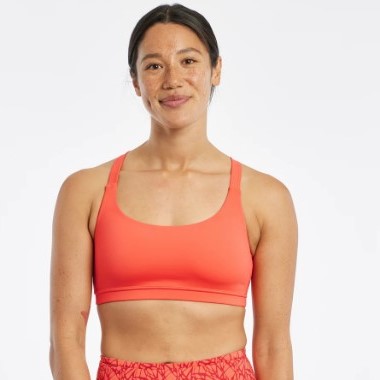 When running in the heat, the extra material of a sports bra can make a sweaty situation even sweatier, but the minimalist style of the Oiselle Hi Twenty Bra makes it our top pick when temperatures rise. Its breathability and simplicity make it one of our top picks in our best sports bras for running guide. The racerback-style elastic straps are thin but supportive and held in place with a mesh panel in the back that releases heat better than other sports bras made with a thicker fabric.
When running in the heat, the extra material of a sports bra can make a sweaty situation even sweatier, but the minimalist style of the Oiselle Hi Twenty Bra makes it our top pick when temperatures rise. Its breathability and simplicity make it one of our top picks in our best sports bras for running guide. The racerback-style elastic straps are thin but supportive and held in place with a mesh panel in the back that releases heat better than other sports bras made with a thicker fabric.
Running in the heat usually involves sweating, and we appreciated that this bra was easy to get off even when wet. We also experienced no chafing or rubbing issues, even when wearing it with a pack.
This bra is a better option for those with smaller chests, as it doesn’t provide the highest level of support, though it does have two removable cups to provide extra support if needed. Our testers found the support adequate up to a C-cup size. The chest band is snug but runs a little bit small. If you’re in between sizes, you might want to size up.
Shop the Oiselle Hi Twenty BraBest Hydration Pack: Salomon Adv Skin 12 ($165)
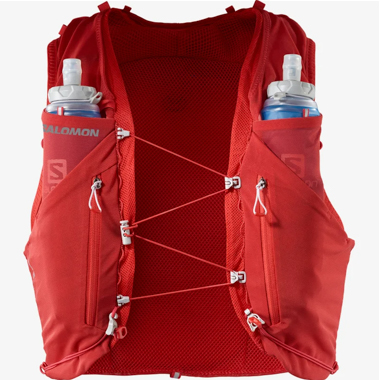 For a hydration pack that can do it all on hot days on the trail, our team’s pick was the Salomon Adv Skin 12, a versatile pack that we also picked as our favorite large-capacity vest in the best running vests guide. It has the right combination of a light, breathable design and ample water and gear storage capacity to make it the ideal hydration pack for running in hot weather.
For a hydration pack that can do it all on hot days on the trail, our team’s pick was the Salomon Adv Skin 12, a versatile pack that we also picked as our favorite large-capacity vest in the best running vests guide. It has the right combination of a light, breathable design and ample water and gear storage capacity to make it the ideal hydration pack for running in hot weather.
This vest, which comes in both a unisex and women’s version, is ubiquitous in the ultrarunning community, and for good reason. It is one of the few packs that feels as comfortable empty as it does packed with gear, making it a good choice for shorter and longer efforts — especially in hot weather.
The pack’s Sensifit construction uses light, stretchy, breathable materials that help keep you cool when the temperatures rise, and its chest straps are easy-to-adjust elastic cords, which allow you to pull the vest as tight as want to prevent uncomfortable bouncing. This pack feels snug around your chest without feeling too tight.
Carrying water on long efforts in the heat is essential, and this pack has you covered: It comes with two 500-milliliter soft flasks that slide into two front pockets and can fit a 1.5-liter bladder in the back compartment, which comes with a removable insulated sleeve to keep your water cool as ambient temperatures rise. Our testers did note that the flasks can be tricky to get back into their sleeves once you take them out.
The pack’s storage capacity is 12 liters, and it has 11 different pockets that serve various functions: large stretchy stuff pockets to carry gels and other nutrition, two zipper compartments to hold cell phones or other more valuable items, and a large, stretchy rear compartment that can fit a day’s worth of gear. A small stuff pocket at the back could fit a fresh shirt or gaiter, and a pass-through tunnel pocket at the bottom of the rear compartment for additional, easy-access storage.
Overall, it’s hard to beat this pack for running in the heat. Our testers have run everything from a supported 50-kilometer races to solo half-day runs in the mountains. For an even closer look at this vest, you can read our in-depth Salomon Adv Skin 12 review.
Shop the Salomon Adv Skin 12Best Sunscreen: Zealios Sun Barrier SPF 45 Sunscreen ($18)
 Regularly using and properly applying quality sunscreen is essential for runners who spend hours exposed to the sun on the trails, especially between 10 a.m. and 4 p.m. — and our team’s top pick was the Zealios Sun Barrier SPF 45 Sunscreen.
Regularly using and properly applying quality sunscreen is essential for runners who spend hours exposed to the sun on the trails, especially between 10 a.m. and 4 p.m. — and our team’s top pick was the Zealios Sun Barrier SPF 45 Sunscreen.
“It’s the only sunscreen I’ve found that keeps me from burning and also doesn’t burn my eyes,” one of our testers wrote. The sunscreen has 16.5% zinc oxide and can filter 98% of UVA and UVB rays, those that cause the most damage to the skin.
It also is water-resistant for up to 80 minutes — the highest water-resistance rating offered by the Food and Drug Administration — so you don’t have to worry about sweating it off immediately. Finally, it is unscented, works well on sensitive skin, and won’t sting your eyes.
Shop the Zealios Sun Barrier SPF 45 SunscreenBest Sunglasses: Smith Motive Sunglasses ($175)
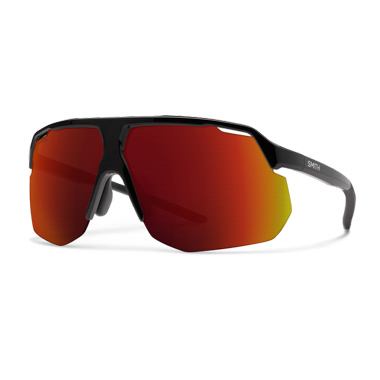 It’s important to wear eye protection when you’re out in the sun for an extended period to keep your eyes safe from excessive UV exposure — and our top pick for sunglasses is the Smith Motive Sunglasses due to their unmatched fit, versatility, and durability.
It’s important to wear eye protection when you’re out in the sun for an extended period to keep your eyes safe from excessive UV exposure — and our top pick for sunglasses is the Smith Motive Sunglasses due to their unmatched fit, versatility, and durability.
These glasses have a large frame and work best for medium-sized faces. Sitting comfortably on the bridge of the nose and weighing just 29 grams, they are featherweight; in fact, you might even forget you’re wearing them when you are running, cycling, or even skiing.
Our primary tester for these glasses wore them for all three sports across 80 hours of activity during the sunny late-spring and early-summer months in Oregon and was impressed by their versatility. They also held up well when inevitably stuffed into a pack without their case, resisting scratches and smudges.
The standout feature of these sunglasses is their Chromapop lens, which sharpens the contrast between colors to make your surroundings more vivid, allowing you to see incredible detail, potentially more than you could with your naked eye. Our tester found that the Chromapop lenses performed well in extremely sunny environments and shaded forests. The glasses also come with clear lenses that are easy to change out on days with less sun — all reasons why we chose them as the best interchangeable lens glasses in our best running sunglasses guide.
In our in-depth Smith Motive Sunglasses review, you can read more about these sunglasses, which we also feature in our best running gear guide.
Shop the Smith Motive SunglassesBest Electrolyte Powder: Skratch Labs Hydration Sport Drink Mix ($22)
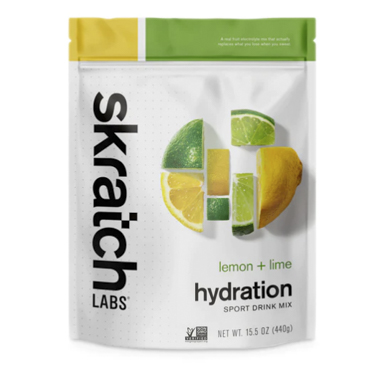 While drinking plenty of water — see the sections below for specific guidance — is the most important factor in staying properly hydrated and fueled during a hot-weather run, many runners also mix in an electrolyte powder to replace lost fluids and salt. Our top pick of electrolyte powders to do this is the Skratch Labs Hydration Sport Drink Mix.
While drinking plenty of water — see the sections below for specific guidance — is the most important factor in staying properly hydrated and fueled during a hot-weather run, many runners also mix in an electrolyte powder to replace lost fluids and salt. Our top pick of electrolyte powders to do this is the Skratch Labs Hydration Sport Drink Mix.
Skratch has become close to ubiquitous in the North American trail running community, as the Colorado-based company often donates hydration mixes to local races, so chances are you’ve seen it before. The mix includes two types of sugar — fructose and glucose — and each scoop has 80 calories, 20 grams of carbohydrates, and 380 milligrams of sodium, as well as small amounts of calcium, potassium, and magnesium to mimic the electrolytes lost in sweat.
There are seven different flavors, with one — raspberry limeade — containing 50 milligrams of caffeine. You can buy the powder in a variety of packages: a 60-serving bag, a 20-serving bag, a pack of 20 individual servings, or single-serving packs. The mixes contain no dyes or additives.
Skratch is light on the stomach and is something we found we could drink for an effort spanning multiple hours, especially if we brought multiple flavors. A single serving is for 12 to 16 ounces of water, but it would also work in a bigger flask. If you’re a heavy sweater or running in hot weather, you could mix in two servings to get some extra calories and sodium, though a double serving will be very sweet.
We appreciated this mix’s taste, electrolyte concentration, and flavor options enough to include it in our best electrolyte powders guide.
Shop the Skratch Labs Hydration Sports Drink MixBuyer’s Guide: How to Choose the Right Hot Weather Running Gear for You
Running in mid-summer heat is dreaded by many: It can be uncomfortable, difficult, and dangerous if not done correctly. Having the best running gear for hot weather can make a huge difference in comfort.
There’s a lot of science about how heat affects the human body in motion. There is no question that running in the heat leads to a decrease in running performance, but taking certain steps can minimize the heat’s effects and allow a runner to get more out of the effort.
If you find yourself working harder in the heat to run at the same pace as you do when temperatures are lower, and you have an elevated heart rate, don’t worry: These are normal physiological effects of your body trying to stay cool as it shifts blood from your muscles to the blood vessels near your skin for increased cooling. Running in the heat can also make eating more difficult as blood is moved away from the stomach and to the skin for cooling.
If you’re new to running in the heat, you can learn more about the basics of running in hot weather and how to stay safe. Wearing clothing designed for hot-weather running, like the Montane Men’s Dart Nano T-Shirt and Oiselle Hi Twenty Bra, can help keep your body temperature at a safe level.
The Importance of Staying Cool
There’s no debate that heat will slow your running. In a study of road marathoners, runners’ times slowed between 1.6% and 3% for every 10-degree increase over 55 degrees Fahrenheit, which is a significant effect. As temperatures continue to rise, it can lead to gastrointestinal distress, heat exhaustion, and, in the most extreme cases, heat stroke and death. Running in the heat requires a healthy respect for the conditions and attention to how the body is responding.
Low-level heat distress can result in nausea and general discomfort. As the situation worsens into heat exhaustion, a runner may experience heavy sweating, increased pulse, vomiting, fatigue, goosebumps, headaches, and dizziness. When a runner’s body temperature reaches 104 degrees Fahrenheit (40 degrees Celsius), it is considered heat stroke and requires immediate medical treatment.
Taking steps to keep a body cool and slowing down or stopping if you start to overheat can help prevent these types of serious issues. Wearing a hat with a brim, like the Patagonia Duckbill Trucker Hat, or a neck gaiter, like the Buff CoolNet UV Half Neckwear, can keep the sun off your face and neck and help cool your body.

The Oiselle Hi Twenty Bra was our top pick for running in hot weather. Photo: iRunFar/Eszter Horanyi
Strategies for Staying Cool
Staying cool is a matter of reducing the effect of the sun’s radiant heat, maximizing evaporative cooling from your skin, and managing the excess heat your body produces while running. The best running gear for hot weather can do all three.
Since bodies are only about 30% efficient — meaning around 70% of the energy you burn turns into heat — it’s important to realize that strenuous efforts in the heat can lead to rapid overheating. There are several ways to make a hot-weather run more successful.
- Minimize heat exposure — While some situations require running in the heat, like during a race or in a location where it’s simply always hot, many runners can make choices that help them avoid the worst of the heat. Running in the mornings and evenings — before 10 a.m. and after 4 p.m., when the sun’s rays are less intense — is an easy way to avoid the sun’s full heat, as is choosing to run in a shaded area.
- Maximize evaporative cooling — The body sweats in order to increase evaporative cooling from the skin. Whether sweat or external water, moisture on the skin can increase energy transfer between your skin and the surrounding air and keep you cooler. Splashing water on your skin, dunking a shirt like the rabbit EZ Tee Perf SS in water and putting it back on, or jumping in a lake or other body of water can quickly drop your body temperature. Wetting a hat or neck gaiter, like the Buff CoolNet UV Half Neckwear, is also a great way to provide ongoing cooling as you run. There are a lot of blood vessels in the neck and around the wrists, so keeping those areas cool can have a larger-than-expected effect on your body’s overall temperature.
- Wear a hat and sunglasses — Keeping the sun off your head and face by wearing a hat with a brim, like the Patagonia Duckbill Trucker Hat, is a simple, effective way to stay cooler. Similarly, limiting UV exposure to your eyes by wearing a good pair of hot-weather sunglasses, like the Smith Motive Sunglasses, is another easy way to minimize the sun’s effects on your face. You can read more about hats and sunglasses in our best running hats and best running sunglasses guides.
- Hydrate properly — More than half of your body is water. Running in the heat can lead to rapid moisture loss through sweat and respiration, and runners can find themselves several pounds lighter after a hot-weather run. While it may be impossible to drink enough to replace all evaporating water during a hot run, some level of hydration is important for optimal performance. Wearing a pack like the Salomon Adv Skin 12 can make it easy to carry the water you need for longer hot-weather runs. Most experts agree that drinking to thirst — drinking when you’re thirsty and stopping when you’re not — is the best strategy during hot runs. Mixing in an electrolyte powder, like Skratch Labs Hydration Sport Drink Mix, can help replace lost calories and electrolytes. Most stomachs can only process about a liter of water per hour, and this provides a good baseline drinking goal. You can read more about the basics of trail running hydration and learn how to adjust your drinking strategy to help deal with hot weather.
- Don’t overexert yourself — You’ll have to move slower when running in the heat to keep your body’s core temperature from rising too much. Trying to maintain the same pace as you would on a cooler day can lead to issues, and it’s a good idea to base hot-weather runs on effort rather than speed. If you experience dizziness or nausea, back off the effort until you feel better.

Tank tops and sunglasses are great options for staying cool and protected from the sun. Photo: iRunFar/Eszter Horanyi
Clothing Choices for Staying Cool
Dressing appropriately for the heat can help improve a body’s ability to maintain its core temperature. There are two main schools of thought in choosing the best running gear for hot weather: wearing as little as possible to maximize evaporative cooling directly from the skin or covering up with light-colored clothing to minimize radiant heating on your skin.
Many runners opt to run shirtless when temperatures rise. While this can increase evaporative cooling, it also exposes your skin to the sun’s direct rays, which heats it up more than if covered. Wearing sunscreen, such as Zealios Sun Barrier SPF 45 Sunscreen, on exposed skin is important for skin health, but it can also block the sun’s rays and help keep your skin cooler while still allowing sweat to cool your skin effectively.
The other option is to cover the skin with light-colored, lightweight clothing — and if you’re a clothing minimalist when temperatures rise, you could opt for a tank top like the Oiselle Flyout Trail Tank. This clothing can reflect the sun’s rays away from your body. Loose-fitting clothing — like the Outdoor Research Echo Hoodie — can be highly breathable and provide a high level of cooling if you dunk it in water during a run.
If wearing a long-sleeve shirt seems too hot and restrictive, a short-sleeve shirt can also provide good protection and sun-ray reflection. Highly breathable shirts — like the Montane Men’s Dart Nano T-Shirt and the rabbit EZ Tee Perf SS — can help keep your torso cool, and shorts like the Tracksmith Session Shorts and Oiselle Roga Shorts can do the same for your lower body.
Friction, Chafing, and Blisters in the Heat
Chafing and blisters are direct results of friction and heat. Hot-weather running can significantly speed up skin irritation, and the best running gear for hot weather minimizes hot spots and the potential for chafing. Using some sort of lubrication on hot spots can help reduce friction on your skin and alleviate the problem. Having properly fitting socks made of low-friction materials, like those in the Drymax Extra Protection Hot Weather ¼ Crew Socks, is also important.
Wearing a pack when it’s hot out can also cause hot spots. You’ll want to choose a shirt with seams that don’t interfere with a pack’s fit to help reduce the chance of chafing on your back or shoulders. You can explore our favorite shirts for running with a pack in our best running shirts for men and best running shirts for women guides.
Hydration Considerations
There are many different approaches to hydration while running in hot weather, and messing it up, whether by drinking too little water or too much, can lead to anything from a little bit of nausea and dehydration to hyponatremia — which occurs when the sodium levels in your blood are too low — or death. An adequately hydrated body has a certain balance of sodium and other important blood components, and disrupting this balance too much can wreak havoc.
The most straightforward approach to hydration is drinking to thirst, meaning you drink when you’re thirsty and stop when you’re not. This approach works for running in the heat or cold and sitting at your work desk during the day while thinking about running. The basic idea is that your body will let you know if it needs water by making you thirsty. Drinking too much water can lead to hyponatremia, which has symptoms of nausea, headache, and confusion.
Different runners have different hydration strategies while they’re out on a run. Some prefer to take small sips of water regularly, while others will drink larger amounts of water at more infrequent intervals. Both strategies are functional, and sometimes, your individual situation will dictate when and how you drink during a run.
Many runners also mix in some electrolyte powder, like Skratch Labs Hydration Sport Drink Mix, to replace electrolytes lost through sweat. If you’re out for a multi-hour run, you can carry the water and electrolyte powders you need in a hydration pack like the Salomon Adv Skin 12.

Eventual second-place finisher Rod Farvard cools off at the 2024 Western States 100. Photo: iRunFar/Eszter Horanyi
Race Strategies for Hot Weather
Some of the most famous ultra races in the world, like the Western States 100, are notorious for their heat. Even if you don’t find yourself toeing the start line in Olympic Valley, California, you will probably race in the heat at some point in your running journey.
Starting fast when it’s hot out is a good way to overheat your body quickly — and, therefore, a foolhardy racing strategy. It’s much easier to keep a body cool in the first place than to try to cool it down after it’s overheated. Staying hydrated is important, and you’ll want to take every opportunity possible to get your clothes and skin wet in order to cool down your core body temperature. Getting ice to put in your hat or a neck gaiter, like the Buff CoolNet UV Half Neckwear, can provide extra cooling after leaving an aid station.
Since your body sends extra blood to your skin for cooling while running in hot weather, digestion is more difficult. Drinking your calories and electrolytes — like those found in Skratch Labs Hydration Sport Drink Mix — instead of eating them can help take the load off your digestive system and prevent nausea.
During an ultra that spans a day and goes into the night, it’s often wise to meter your efforts in the heat of the day and then increase your pace as the temperature drops after the sun goes down. Your body will be able to push harder when it’s cooler out.
Why Trust Us
At iRunFar, we don’t stay home when outside temperatures rise. Many of our testing team members live where summer temperatures can reach the triple digits. We’ve spent decades experimenting with different hot-weather running setups and tested them in the harshest and hottest ultras, such as the Marathon de Sables in Morocco.
We’ve tested gear options extensively so that we can provide the best recommendations for running in a variety of hot-weather conditions, ranging from hot and dry to muggy and wet.
Our team of experienced trail runners, ultrarunners, and road runners created this guide. We wore everything from long-sleeve shirts for sun protection to tank tops and bucket hats to technical running hats and shorts of every length.
We also used neck gaiters, various types of sunscreen, and a huge variety of sunglasses to keep ourselves protected from the sun — all so that we could offer our best recommendations for the best running gear for hot weather.

The Patagonia Duckbill Trucker Hat and Men’s Strider Pro Shorts – 5″ can help keep you cool during hot runs. Photo: iRunFar/Eszter Horanyi
Frequently Asked Questions About Running in Hot Weather
Is it dangerous to run in the heat?
Running in the heat can be dangerous but can also be done safely. If you’re new to running in the heat, it’s a good idea to brush up on the basics of how to run smart in hot weather. Heat will stress the cooling systems of your body and force it to route more blood to the skin for increased cooling. This results in less blood going to the muscles, increased heart rate, and possible gastrointestinal distress, especially if you’re trying to eat while running.
Not taking the proper precautions in the heat could lead to heat exhaustion and, eventually, heat stroke, which can be deadly. Having the right gear, from a pair of Smith Motive Sunglasses on your face to Drymax Extra Protection Hot Weather ¼ Crew Socks on your feet, to help keep you cool, protected from the sun, and chafe-free can go a long way toward keeping you safe and comfortable as temperatures rise.
If you’re experiencing a lack of appetite, lightheadedness, or excess sweating, you might be approaching heat exhaustion and need to dial back your effort and find a way to cool your body down. Heat exhaustion can quickly develop into heat stroke, which includes symptoms such as confusion, dizziness, and disorientation. You can read more about how to deal with heat-related illnesses so that you know what to do if something has gone wrong.
Do I need to wear a hat when running in the heat?
When running, wearing a hat or a visor, such as the Patagonia Duckbill Trucker Hat, can shade your face from the sun. This not only keeps your skin from heating up, but it can also help protect your eyes from harmful UVA and UVB rays.
Hats are also helpful for dunking in the water while running, whether in a mountain stream or a water cooler at an aid station, and can provide ongoing cooling as you keep running. Visors provide many of the same advantages as hats with more breathability, though they offer less protection for the top of your head.
Are there advantages to running without a shirt?
The key to staying as cool as possible is to minimize the heating of your skin by the sun while maximizing evaporative cooling. Clothing can trap heat next to your skin and increase your skin’s temperature. Not wearing a shirt can significantly increase evaporative cooling at the admittedly significant expense of exposing your skin to the sun.
Wearing a layer of sunscreen, like Zealios Sun Barrier SPF 45 Sunscreen, is important if you run shirtless, as it protects your skin from harmful sun rays and can provide a little cooling by reflecting the sun’s rays.
What’s the best clothing material for running when it’s hot out?
In most cases, you’ll want to wear clothing made from synthetic materials that are breathable and wicking. Our testers found the perforated material of the rabbit EZ Tee Perf SS and 100% recycled polyester of the Patagonia Men’s Strider Pro Shorts – 5″ to be highly effective at keeping them cool.
Wool is also great for wicking, and modern merino wool garments can be incredibly thin and lightweight. Many runners swear by wool for cold and warm weather due to its moisture-management properties. It also won’t stink after a run like many synthetic materials. You can read more about our favorite wool products, including options that perform well in warm weather, in our best wool running apparel guide.
Some runners wear cotton during hot runs when ample water is available to douse clothes. The cotton fibers hold on to the water, something that is generally frowned upon while running, but this can be a beneficial property if you want the clothing you’re wearing to stay wet for as long as possible. Cotton is more prone to chafing when wet, so you may only want to turn to this strategy for shorter efforts.

Some runners wear long sleeves to stay cool when the temperatures rise, while others prefer short sleeves. Photo: iRunFar/Eszter Horanyi
Is wearing less clothing better when it’s hot out?
There are several components to keeping your body cool and wearing minimal clothing can increase the evaporative cooling of your skin. Many runners look forward to temperatures getting warm enough that they can strip down to the bare minimum of clothing. However, not having a shirt on exposes your skin to the sun’s direct rays and can increase heating. Wearing a light-colored shirt, long or short sleeve, can reflect the sun’s rays and keep your skin temperature lower.
Brands design sunshirts like the Outdoor Research Echo Hoodie for spending long hours under the sun. Many runners can find long-sleeve shirts too hot, especially for harder efforts where they’re producing a lot of excess heat, but even a short-sleeve shirt, like the Montane Men’s Dart Nano T-Shirt and rabbit EZ Tee Perf SS for women, can provide a good amount of protection.
How much water do I need to drink when running in the heat?
The human body is more than half water, and maintaining the right balance of liquid and nutrients is important. While many runners realize the dangers of being dehydrated, they also need to be aware of hyponatremia, a situation in which they’ve drank too much water and offset the sodium balance in their blood.
The current community consensus is to drink when you’re thirsty and stop drinking when you’re no longer thirsty. The maximum amount of water most stomachs can process in an hour is 1 liter, so drinking more than that can lead to sloshing and stomach distress.
If it’s hot, carrying some water is a good idea, even if you’re not planning to be out for long. Carrying a lot of water on hot-weather runs where you don’t have a place to refill bottles can be cumbersome, but a pack like the Salomon Adv Skin 12 can make it easier and more comfortable.

Wearing a pack like the Salomon Adv Skin 12 can help you carry all the essentials for running in hot weather. Photo: iRunFar/Eszter Horanyi
Should I prehydrate before I run in the heat?
It’s nearly impossible to replace all the water your body loses through sweat and respiration during a hot-weather run, so it’s important to go into runs well-hydrated. The drink-to-thirst principle also pertains to day-to-day life and can be a good guide to drinking water. If your urine is a light yellow color, it’s a good indicator that you’re well-hydrated and ready to run in hot weather.
Drinking a lot of water right before a hot run is generally not a good idea as it can sit in your stomach and make you uncomfortable. Carrying a hydration pack like the Salomon Adv Skin 12 can keep you drinking so that you maximize your hydration while running in hot weather.
Can I acclimate to running in hot weather?
While many runners just throw their hands up and claim that they just don’t run well in the heat, there are steps you can take to help your body operate efficiently when temperatures rise. While proper heat acclimation can take a long time, studies have shown that a few hot-weather workouts can help your body make physiological adaptations to stay cooler in the heat. You can read more about the science of heat adaptation and adjust your training accordingly.
If you’re not acclimated, you can still take small steps to stay cool that will make a big difference. Wearing a wet Buff CoolNet UV Half Neckwear on your neck can cool your body more than expected due to the proximity of blood vessels to the skin in the area.
Call for Comments
- Calling all runners who venture out into hot weather: Given your expertise, what hacks do you recommend for others running in hot and humid conditions?
- How do you adapt your training when the heat is extreme and unsafe?
- What is your favorite clothing and gear to use in the summer?

Running uphill can generate a lot of heat, so wearing clothing to keep you cool is even more important. Photo: iRunFar/Eszter Horanyi
